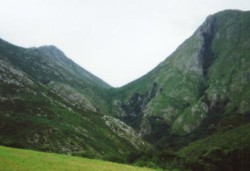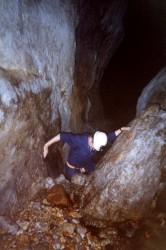

Introduction
Site list (GPS fixes) Walks (GPS tracks) Video clips Panoramas
Electronic projects:
Bat detector
Lamp tests
µ-controlled lamp
SEPIC-based lamp
ISP isolators
Making SMT boards
Expedition logs:
Spain 1973, 1974,
1975, 1976, 1977,
1979, 1982, 1983,
1985, 1986, 1987,
1988, 1989, 2000,
2001, 2002, 2003,
2004, 2005, 2006,
2007, 2008, 2009,
2010, 2011, 2012,
2013, 2014, 2015,
2016, 2017, 2018,
2019, 2020, 2021,
2022, 2023
Mexico
New England
Translation:
Name: Cueva Tinganón; also ‘official’ name (in gazetteer and on newer maps): Cueva del Tenganón
Location: Llovio area; see walking GPS track
GPS: N43°25'46" W5°02'15" (resurgence)
UTM: 30T 335.20 4810.73 (resurgence)
Lambert: 4906 9816 (resurgence, alt. 160m), 4910 9813 (sink, alt. 246m)
Map: Ribadesella?
Survey:
by Collis/Cowlishaw/Evans/Laverty/Newton 1974–75 300dpi BCRA Grade 5d
Description: Huge cave, often 20m and more wide and/or high. No tackle needed for most of the cave, although exiting or entering the top entrance can be slippery and dangerous. Best trip is from resurgence, up to top, and back out of the resurgence. See OUCC report 1972 » (Guy Cox) and later survey » (Mike Cowlishaw et al.).
Visits:
1974 – survey trip (New Year’s trip)
1975a – surveying
1975b – through trip on way back from Cueva Negra
1975c – more surveying
1985 – through trip, Alt. 149m→239m, ~2 hours, unable to freeclimb slimy top entrance to Negra; chocolate bar incident
1987 – tourist trip with Leonardo and Giovanna, and their friends
2000 – to top entrance and back
2003 – investigated possible feeder (on way back from Negra)
2008 – accurate GPS fix and track, to top and back, 1hr:40
Survey Notes (From >>OUCC Report 1975–76 », MFC)
Instruments: First and third surveying trips used Suunto compass, pendulum clinometer, Fibron tapes. Second surveying trip used Suunto compass and clinometer and Fibron tapes, however, the clinometer was found to be faulty, so only selected parts of the data were stable.
Methods: Both leap-frog and follow-through techniques were used, zigzagging in the larger parts of the passage. Readings were taken to the nearest half degree and ten centimetres. Instruments were hand-held with especial care being taken to maintain station positions to better than 10 cm.
Calibration: The compass was calibrated using the Pole Star and mountain-top to mountain-top bearings (and relying on maps).
B.C.R.A. Gradings: From lower entrance to upper rock pillar: Better than Gr 5. Loop near top entrance: Better than Gr 5. Central rift: Gr 5. All detail to grade d – much entered on working drawing of cave while actually in the cave.
Calculations: A sophisticated network-solving computer program was used to calculate coordinates and compare the various sets of data (the program is interactive and uses a weighted least squares method to solve networks – see B.E.C. Cave Notes 1975. Calculations were initially made in the field on a pocket calculator – this showed the errors in the second surveying trip and so proved to be a worthwhile exercise.
Closed Loops: A large number were available since much of the cave had been surveyed several times. Misclosures for the second surveying trip were horrendous due to the gross errors attributable to the faulty clinometer. (Very little of the data from this trip was used in producing the final line). Misclosures after resurveying were good – e.g., 0.647m for the top loop. Errors were distributed appropriately by the computer program described above.
Plotting: The master line was laid out by another computer program at a scale of 1:750, and the survey was drawn on Permatrace to maintain integrity. In all, 1600 metres of surveying was carried out for the 720 metres of passage. PLEASE DO NOT ASK US TO RESURVEY!

